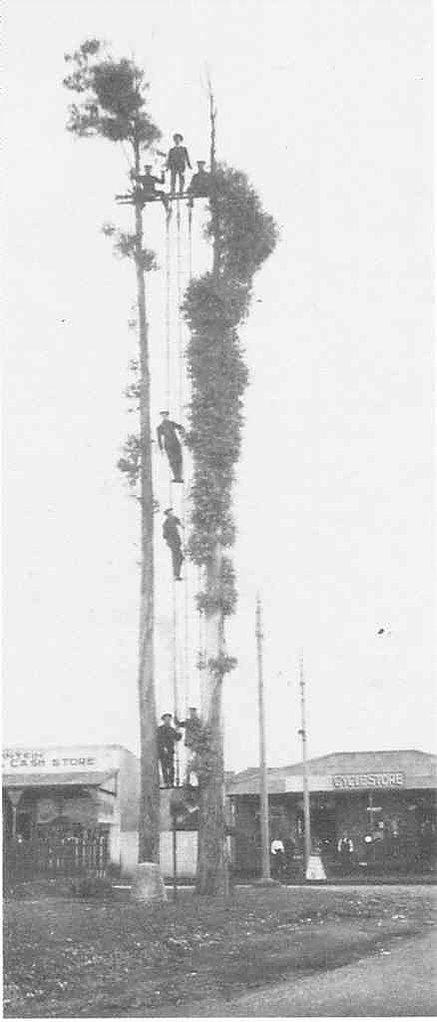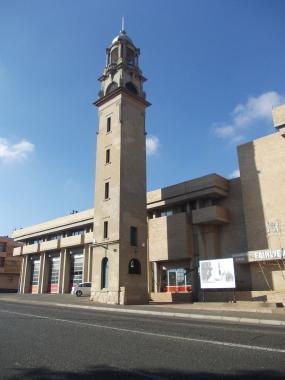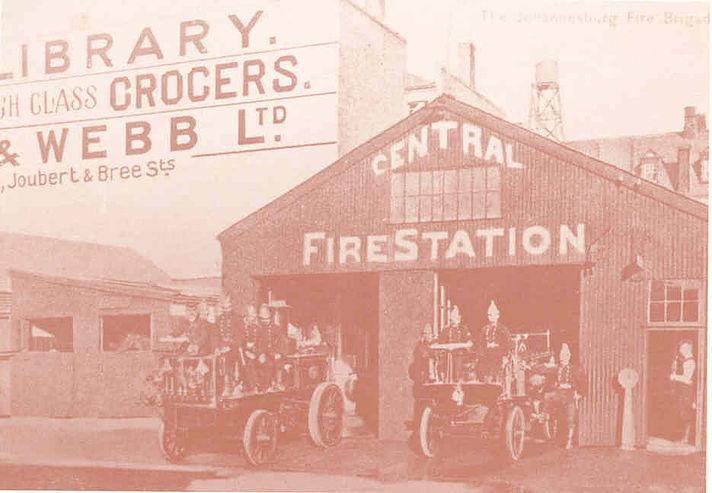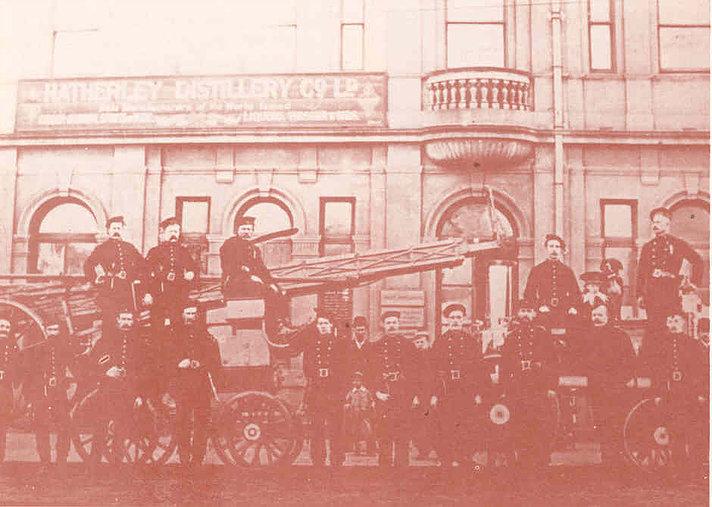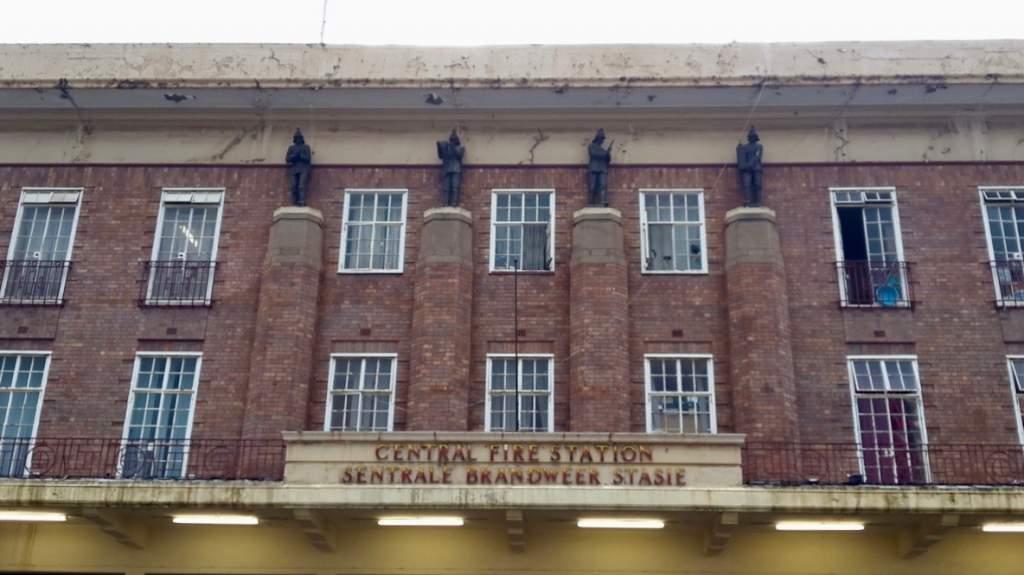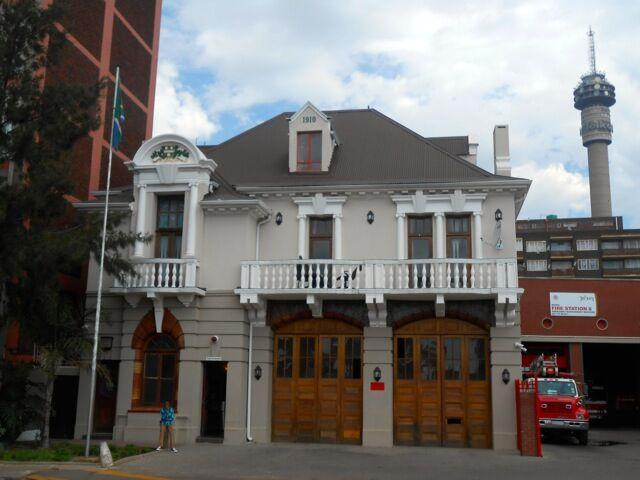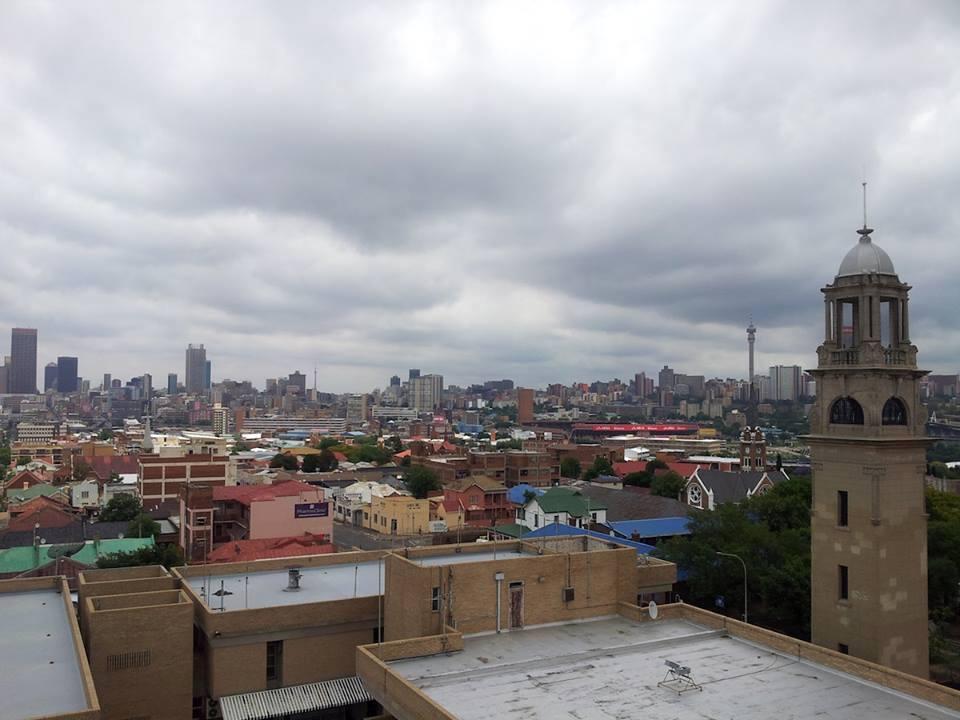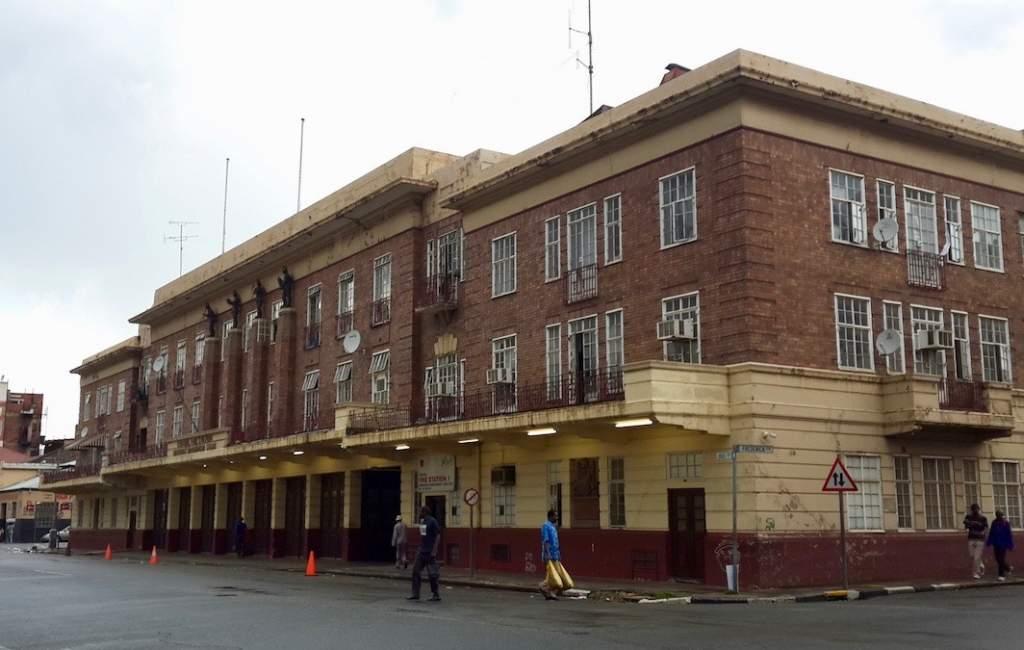
Disclaimer: Any views expressed by individuals and organisations are their own and do not in any way represent the views of The Heritage Portal. If you find any mistakes or historical inaccuracies, please contact the editor.
In the article below, journalist Lucille Davie explores the fascinating history of a few of Joburg's Fire Stations. The piece was first published on the City of Joburg's website on 13 November 2003. Click here to view more of Lucille's work.
The two tall, single-trunk gum trees outside the Turffontein Fire Station were ostensibly used by firemen to spot smoke and potential fires in the southern suburbs. But for the firemen there was a much more important function, sufficient to warrant a plaque in the grass alongside all that exists of the trees today – two stumps in the grass.
A rope ladder was strung between the two 30-metre tall trees, which were several metres apart. The ladder went up about five storeys, where a platform had been erected between the trees.
The famous trees
Now an important part of this story is that the Turffontein Race Course is across the road from the Turffontein Fire Station. The Race Course opened for business three years after Johannesburg was established in 1886. Racing had in fact begun only three months after those first gold diggers hit town, on a course marked out between Natalspruit and Von Brandis Square.
But back to the two gum trees. On race days several firemen used to position themselves on the platform with a marvellous view of the race track and the horses running each race. It seems that in those days betting could take place even after the horses had left their stalls.
Hannes Meiring in Early Johannesburg, its buildings and its people (1985) takes up the story: “They [the firemen] developed an ingenious system of signals to tip off accomplices at Fairview, who dashed off to lay last-minute bets at the Tattersalls in Jeppestown on the horses which could be seen to be leading the field. It did not take the losing bookmakers long to work out what was happening!”
The sad part of this story is that those marvellous gum trees don’t exist any more. Two replacement gum trees soar into the sky at the same spot. In the late 1980s a new, larger fire station was constructed behind the old station, a charming red brick and iron-roofed building still standing on the corner of Turf Club Street and Hay Road, opened in 1910.
The trees were on the corner of the two streets, out the way of the new building, but they were cut down nonetheless. Maybe their time was up anyway – maybe they were buckling, or rotting, or blowing fiercely in the wind, in danger of cracking and collapsing on the building.
So, all that’s left are their large stumps, alongside the two new 15-metre tall gum trees, which are looking healthy, bushy and blowing happily in the breeze.
Turffontein farm
Turffontein was one of the early farms of Johannesburg, owned by Abraham Smit, who died on his farm in 1884, at the age of 73. He had lived there since 1857, according to Meiring. On his death, Paul Andries Ras bought part of the farm. Just south of the race course, Ras found gold in what became known as the Ras Reef.
Walter Casey also bought some of the farm, and in 1889 he had a township of about 170 hectares laid out, on a grid plan with a circular park, the Rotunda Park, and a rectangular park, the Christopherson Park. For many years the township was referred to as Casey’s Township.
Casey starting selling stands in March 1890, says Meiring, and when he died in 1896, ownership of the land passed from him and Ras to the Australian Trust Company, and the township was laid out again in 1902.
There were great hopes of making Turffontein into a weathy suburb, with the two attractive parks as a drawcard, but the dust from the rapidly growing mine dumps put an end to those plans.
In June 1896 400 stands “on Turffontein, or Casey’s Township, adjoining the Racecourse, the most charming suburb in Johannesburg”, were advertised.
Over time Turffontein became a sub-economic suburb, housing mostly miners. It’s still seen today as a working class suburb, dominated by the race course and a fast-growing landfill site in Turffontein Road, growing on the main mine dump of the defunct Village Main Reef gold mine. Those two parks still exist, the attractive round Rotunda Park surrounded by cosy, veranda-fronted houses on small properties.
Those early buildings of the race course still exist too, in red brick, with white fascias and red tile roofs, with long verandas set under luxuriant oak trees and manicured gardens. A large stand has been added and around 58 race days take place each year at Turffontein, with up to 3 000 race goers entering the gates each race day. Otherwise, conferences and weddings fill up the dining room and restaurant during the week. Some 700 horses are stabled there. The race course takes up about 89 hectares and is about seven kilometres from the city centre.
Early fire stations
The Turffontein Fire Station was the southern fire station of the early gold-mining town. In the east was the Fairview Fire Station, built in 1905; in the west the Fordsburg Fire Station, opened in 1907, and in the north the Berea Fire Station, in operation from 1910.
Fairview Fire Station (The Heritage Portal)
In those early days residents had major problems extinguishing fires, mainly because Johannesburg had very sporadic, sparse supplies of water – it’s one of the few large cities in the world that was not built on a river. To make matters worse, those first houses were constructed of wood and iron, with thatch roofs, and once alight, they burnt to the ground within minutes.
It’s believed that the first serious fire happened on 20 December, 1887 - a reed stable in Sauer Street. Residents watched helplessly as the fire burnt, having no water to douse it. The best they could do was do pull down surrounding wooden fences and shacks, to prevent them from catching alight.
Four days later a carpenter’s shop, with tools and three wagon loads of timber, were gutted, according to Anna Smith in Johannesburg Firsts (1976).
Fire bell
According to Debbie Fiansky in Johannesburg Fire and Emergency Services Department – 100 years of Service, after these incidents a fire bell was erected on Market Square, and although the town still didn’t have sufficient water to deal with fires, it could at least raise the alarm, and the police could rush to the scene and control the crowds.
In November 1888 water pipes were laid from a reservoir in Doornfontein, a large well in Auckland Park and a cattle dam on the Braamfontein farm, says Fiansky. But there were still problems. Water pressure was low, and during Johannesburg’s dry winters, the reservoirs remained dry.
In May 1888 the Waterworks, Estate and Exploration Company got involved. They purchased around £2 000 worth of equipment, and the Sanitary Board built a small iron shanty on Market Square to store the equipment, but there was still no fire brigade.
The situation was getting desperate – on 24 May 1888 a fire at Short’s Outfitters spread through the block and destroyed three businesses. The next day The Star’s offices were burnt down, although they managed to publish the story the following day.
More fires occurred: the premises of Garden and Company; the Globe Theatre, opened in 1889, and its neighbouring bar (although the residents managed to remove all the liquor before the flames got to it); and Fillis’s Circus. Despite the owners having got hold of 25 buckets and filling them with sand, the Circus was gutted.
The freemasons came to the rescue. The Buffalo Freemasons formed the Volunteer Salvage Corps and Fire Brigade, chaired by Sam Goodman, says Fiansky. The next major hurdle was to raise funds. Insurance companies gave a collective amount of £300 towards start-up costs, and the Sanitary Board offered £25 per month towards running costs, and the Johannesburg Town Fire & Salvage Brigade was born.
The Old Central Firestation
First fire service
A chief officer, three paid firemen, an engineer and a foreman were appointed. In addition, the Salvage Brigade was to be a voluntary organisation. The fire station was a tin shack on Market Square, which served the town for four years.
The men were supplied with uniforms. Their fire engine was a wooden wagon with a manual pump. When the fire bell in the square sounded the alarm, black messengers dashed around to the homes of the firemen, who then rushed to the square to collect the fire engine and scrabble to the scene of the fire.
This engine was replaced in 1892 was a steam-driven fire engine which could shoot a jet of water 30 metres in the air. Horse-drawn fire engines were used until the end of World War 1.
The tin shack had become too small by the early 1890s and temporary premises were taken on the corner of Kerk and Von Brandis streets until a larger station was built on the corner of Von Brandis and Jeppe streets.
Old photo of Joburg firefighters
Central Fire Station
In 1909 a new Central Fire Station was opened on Von Brandis Square, to be replaced by the old Central Fire Station in 1928, an attractive three-storey building with a copper dome-topped tower on its corner. In 1932 a new Central Fire Station, taking the whole block on the corner of Frederick and Von Brandis streets in Marshalltown, was opened, and still remains the city’s central fire station. Four cast iron, life-sized figures of firemen were placed above the entrance, still to be seen today.
Life-sized figures of firemen above the entrance (The Heritage Portal)
Of the other four early stations, only two still exist, although they have undergone significant changes. The Berea Fire Station still exists with its delightful balcony and attic window, described by some as a “doll’s house”. These days it looks a little lost surrounded by the skyscrapers of Hillbrow.
Berea Fire Station (The Heritage Portal)
The Fordburg Fire Station no longer exists but the area is served by the Brixton Fire Station, opened in 1961.
The old Turffontein Fire Station still stands, but is dominated by the not-too-attractive new building behind it, completed in 1990. The old building is used for monthly meetings and its walls are covered in fire department emblems from around the world, shiny brass helmets and other fire fighting memorabilia. It still retains its charm with its wood slated ceilings, large wooden windows, and wooden floor.
The Fairview Fire Station was the “first station to have been built to acceptable departmental specifications in the city”. When opened by the mayor in 1904 it was described as being “the most up-to-date station in Africa”.
So 70 years later it was decided that this station was again to be the most up-to-date station in Africa. Its facilities and living quarters had become inadequate, signalled in its high staff turnover, a problem experienced at all stations because of poor salaries and insufficient staff accommodation.
Because of its central location to growing industrial areas surrounding it, it was decided to rebuild the entire station, but leave the tower. The first brick was laid in 1975 and construction was completed in 1983. The tower is a landmark in the area, soaring above the unattractive modern building, but in need of attention with bits of concrete occasionally falling from its attractive domed canopy.
The Fairview Fire Tower and Joburg Skyline (The Heritage Portal)
In 1972 Soweto got its first station with the opening of one in Jabulani.
Nowadays the city boasts 28 fire stations, the most recent being opened in Orange Farm and Lawley in October, with Diepkloof and Dobsonville in Soweto getting their stations in March. New stations are still to be opened in Diepsloot and Ruimsig, far north of the city. In all there’re 103 fire engines servicing the citizens of Johannesburg, together with 49 ambulances and 11 response cars.
Lucille Davie has for many years written about Jozi people and places, as well as the city's history and heritage. Take a look at lucilledavie.co.za
Comments will load below. If for any reason none appear click here for some troubleshooting tips. If you would like to post a comment and need instructions click here.

